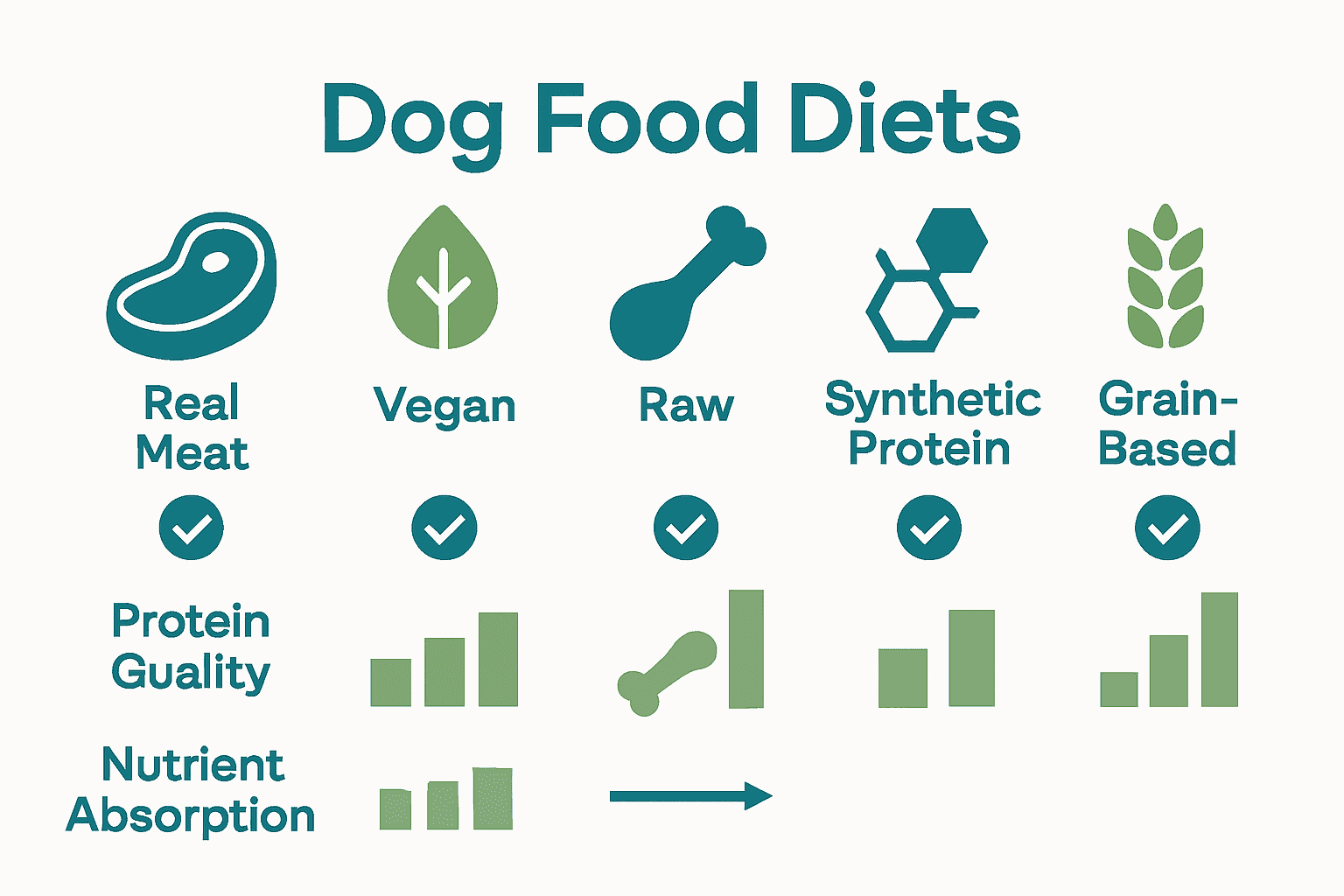
Complete Guide to Real Meat Dog Food
Share
Most pet owners are surprised to learn that not all meat-based dog foods deliver the same health benefits. With so many options lining the shelves, it’s easy to get caught up in marketing buzzwords while missing key differences that impact your dog’s health. Understanding what sets real meat dog food apart—and seeing through common myths—helps you make smarter choices for lasting well-being. Discover what genuine quality really means when it comes to your dog’s daily nutrition.
Table of Contents
- Defining Real Meat Dog Food And Common Myths
- Types And Variations Of Real Meat Formulas
- Key Nutritional Benefits For Dogs
- Ingredient Sourcing And Label Transparency
- Comparing Real Meat To Alternative Diets
Key Takeaways
| Point | Details |
|---|---|
| High-Quality Protein | Real meat dog food emphasizes minimally processed, high-quality protein sources that align with dogs’ natural dietary needs. |
| Misconceptions Clarified | Many myths exist regarding meat-based diets; nutritional quality varies based on ingredient sourcing and preparation methods. |
| Nutritional Benefits | A diet rich in real meat supports muscle development, skin health, digestive function, and overall canine wellness. |
| Ingredient Transparency | Understanding ingredient sourcing and labeling is crucial for dog owners to ensure their pets receive optimal nutrition. |
Defining Real Meat Dog Food and Common Myths
Real meat dog food represents a nutritional approach focused on providing canines with high-quality, minimally processed protein sources that closely mimic their natural dietary requirements. Unlike heavily processed alternatives, real meat dog food contains substantial proportions of fresh, identifiable meat ingredients that deliver essential nutrients in their most bioavailable form.
According to The Kennel Club, there are several common misconceptions surrounding meat-based diets for dogs. While some believe raw or minimally processed meat diets are automatically superior, the reality is more nuanced. Nutritional quality depends on multiple factors, including ingredient sourcing, preparation methods, and balanced nutrient composition.
Key characteristics of authentic real meat dog food include:
- Minimum 35% freshly prepared meat content
- Provenance-sourced protein from identifiable animal sources
- Gentle cooking processes that preserve nutritional integrity
- Absence of artificial preservatives and unnecessary fillers
- Balanced blend of proteins, healthy fats, and essential micronutrients
Understanding the myths is crucial. Blue Cross emphasises that while dogs are omnivores capable of consuming diverse diets, ensuring nutritional completeness requires careful consideration. Simply labelling a product as “meat-based” does not guarantee optimal nutrition. Dog owners must look beyond marketing claims and evaluate the actual protein quality, nutrient profile, and digestibility of their chosen food.
Our gentle-cooked kibble, prepared at precisely 82°C, represents an ideal solution. By carefully preserving meat nutrients while eliminating potential bacterial risks associated with raw diets, we provide a scientifically formulated nutrition option that supports your dog’s health comprehensively. Each recipe includes human-grade ingredients and essential prebiotics like MOS and FOS, ensuring digestive wellness alongside exceptional protein intake.
For those seeking deeper insights into canine nutrition, our Complete Guide to Protein Source for Dogs offers comprehensive information about selecting the right protein sources for your furry companion.
Types and Variations of Real Meat Formulas
Real meat dog food offers a diverse range of nutritional formulas designed to meet the unique dietary needs of different dogs. The Kennel Club highlights two primary approaches to meat-based nutrition: homemade and commercially prepared formulas, each offering distinct advantages for canine health.
Single Protein Formulas represent one of the most targeted real meat nutrition strategies. These recipes focus on one primary protein source, which can be particularly beneficial for dogs with specific dietary sensitivities or allergies. Typical single protein options might include:
- Chicken-based formulas
- Lamb-specific recipes
- Beef-focused nutrition
- Fish-only preparations
- Duck or turkey exclusive diets
According to Dog Nutrition, the trend towards natural dog foods has expanded to include sophisticated variations like grain-free formulas and recipes incorporating organic meats. These advanced formulations go beyond basic nutrition, addressing specific health requirements and lifestyle needs for different dog breeds and ages.

Real meat variations can also be categorised by preparation method and nutritional focus:
- Gentle-Cooked Kibble: Prepared at 82°C to preserve nutrients
- Raw-Inspired Formulas: Minimally processed to retain natural nutritional profile
- Limited Ingredient Diets: Designed for dogs with sensitive digestive systems
- Breed-Specific Nutrition: Tailored formulas for different sized dogs
For dog owners seeking more nuanced insights into protein sources, our Understanding Single Protein Dog Foods guide provides comprehensive information about selecting the most appropriate meat-based nutrition for your canine companion.
Key Nutritional Benefits for Dogs
Real meat dog food provides a comprehensive nutritional profile that supports canine health from nose to tail. The Kennel Club highlights the potential benefits of high-quality protein sources, noting that well-prepared meat diets can contribute to remarkable improvements in overall dog wellness.
Key nutritional benefits of real meat dog food include:
- Enhanced Muscle Development: High-quality protein supports lean muscle maintenance
- Improved Coat and Skin Health: Essential fatty acids promote shinier, healthier coat
- Better Digestive Function: Easily digestible proteins reduce gut stress
- Increased Energy Levels: Nutrient-dense proteins provide sustained energy
- Stronger Immune System: Bioavailable nutrients support immune function
Blue Cross emphasises that the critical factor in canine nutrition is ensuring a nutritionally complete diet. While meat provides excellent protein, the balance of nutrients matters most. Our gentle-cooked kibble, prepared at 82°C, ensures that each meal delivers optimal nutrition without compromising ingredient integrity.
Protein quality is paramount. Unlike plant-based alternatives, real meat provides complete amino acid profiles that dogs need for optimal health. These proteins support critical bodily functions, from muscle repair to enzyme production. The bioavailability of nutrients in real meat far exceeds processed or synthetic alternatives, meaning dogs can more effectively absorb and utilise the nutritional content.
For pet owners seeking deeper insights into comprehensive canine nutrition, our Understanding Holistic Dog Nutrition guide offers an extensive exploration of how diet impacts overall pet wellness.
Ingredient Sourcing and Label Transparency
Real meat dog food demands rigorous transparency in ingredient selection and labeling. Sense About Science highlights the critical importance of understanding precisely what goes into your dog’s food, emphasizing that vague terms like ‘meat meal’ or ‘animal by-products’ can obscure true nutritional content.
Key aspects of transparent ingredient sourcing include:
- Provenance Tracking: Identifying specific meat sources
- Clear Ingredient Declarations: Listing exact protein origins
- Minimal Processing: Preserving nutritional integrity
- Human-Grade Quality: Ensuring top-tier ingredient standards
- Traceability: Complete supply chain documentation
Our approach goes beyond standard labeling practices. We provide detailed ingredient profiles that specify:
- Exact meat source (e.g., Scottish lamb, British chicken)
- Processing temperature (gentle cooking at 82°C)
- Nutritional breakdown
- Ingredient origin
- Preparation method
Transparency isn’t just about listing ingredients—it’s about building trust. By sharing comprehensive information about our protein sources, preparation methods, and nutritional content, we empower dog owners to make informed dietary choices.
Our commitment means no hidden ingredients, no mysterious ‘meat meals’, just pure, traceable nutrition.
For dog owners looking to become ingredient-savvy, our How to Read Dog Food Ingredients guide offers an in-depth exploration of decoding pet food labels and understanding what truly matters in your dog’s diet.
Comparing Real Meat to Alternative Diets
Real meat dog food represents a nutritionally complex approach to canine nutrition, offering distinct advantages over alternative dietary strategies. While emerging research explores diverse feeding options, the fundamental requirement remains consistent: delivering comprehensive nutritional support tailored to dogs’ biological needs.
Dietary alternatives compared:
- Real Meat Diets: Protein-rich, bioavailable nutrients
- Vegan Dog Foods: Plant-based protein sources
- Raw Diets: Unprocessed, minimally cooked ingredients
- Synthetic Protein Diets: Laboratory-developed nutritional formulas
- Grain-Based Diets: Carbohydrate-focused nutritional approaches
Winchester University presents intriguing research suggesting that nutritionally balanced alternative diets can potentially meet canine nutritional requirements. However, our approach emphasises that real meat provides superior protein bioavailability and more naturally aligned nutritional profiles for dogs’ evolutionary dietary patterns.
Our gentle-cooked kibble, prepared at 82°C, bridges the gap between alternative dietary strategies. By preserving meat’s nutritional integrity while eliminating potential bacterial risks, we offer a scientifically formulated solution that delivers optimal protein absorption, essential fatty acids, and comprehensive micronutrient support. The inclusion of prebiotics like MOS and FOS further enhances digestive health, making our approach more sophisticated than simple meat or plant-based alternatives.
For dog owners seeking deeper insights into dietary comparisons, our Understanding Raw vs Kibble Dog Food guide provides comprehensive perspectives on navigating the complex landscape of canine nutrition.

Unlock the Full Benefits of Real Meat Nutrition for Your Dog
Choosing the right diet for your dog is a challenge when you want real meat quality without compromising safety or nutrition. This guide highlights the importance of gentle cooking, transparent ingredient sourcing and balanced nutrients to support muscle strength, coat health and digestive wellness. Many dog owners struggle to find trustworthy food that delivers on meat content and bioavailability without fillers or artificial additives.
Discover how you can provide your dog with premium nutrition through our Dry Dog Food | Grain-Free & Science-Backed Kibble range crafted with fresh meat and precisely cooked at 82°C to preserve natural goodness.

Make the switch to scientifically designed meals that meet your dog’s natural dietary needs while ensuring safety and digestibility. Visit ultimatepetfoods.co.uk today and find tailored solutions including Dog Treats - Healthy & Natural with Functional Benefits to complement your dog’s health journey. Act now and give your companion the nutrition they deserve for lasting vitality.
Frequently Asked Questions
What is real meat dog food?
Real meat dog food focuses on providing high-quality, minimally processed protein sources that meet canines’ natural dietary requirements. It typically contains a minimum of 35% freshly prepared meat and avoids artificial preservatives and unnecessary fillers.
What are the benefits of feeding my dog real meat dog food?
Real meat dog food offers numerous benefits, including enhanced muscle development, improved coat and skin health, better digestive function, increased energy levels, and a stronger immune system due to its high-quality protein and nutrient profile.
How does real meat dog food differ from other dietary options like vegan or grain-based diets?
Real meat dog food is rich in bioavailable protein sources that align with a dog’s evolutionary dietary needs, whereas vegan or grain-based diets primarily rely on plant protein, which may not provide a complete amino acid profile necessary for optimal health.
What should I look for when choosing real meat dog food?
When selecting real meat dog food, look for clear ingredient declarations specifying the protein source, a minimum of 35% meat content, gentle cooking processes, and essential nutrients like prebiotics ensuring digestive wellness.
